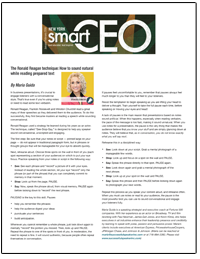The Ronald Reagan Technique: How to Sound Natural While Reading Prepared Text

by Maria Guida
© copyright 2016 by Maria Guida. All rights reserved.
This article appeared in the Jan/Feb 2016 issue of Smart CEO Magazine
In business presentations, it’s crucial to engage listeners with a conversational style. That’s true even if you’re using notes or need to read some text verbatim.
Ronald Reagan, Franklin Roosevelt and Winston Churchill read a great many of their speeches as they delivered them to the audience. To do this successfully, they first became masters at reading a speech while sounding conversational.
Ronald Reagan used a strategy he learned during his years as an actor. The technique, called “See-Stop-Say,” is designed to help any speaker sound conversational, unscripted and engaging.
The first step: Be sure that your notes or script — printed large on your page — do not appear in traditional paragraph form, but in phrases or thought groups that will be manageable for your eye to absorb quickly.
Next, rehearse aloud. Choose three spots on the wall in front of you (each spot representing a section of your audience) on which to put your eye focus. Practice speaking from your notes or script in the following way:
- See: See each phrase and “record” a picture of it with your eyes. Instead of reading the whole section, let your eye “record” only the phrase (or part of the phrase) that you can completely commit to memory in that moment.
- Stop: Look up from the page. PAUSE.
- Say: Now, speak the phrase aloud, from visual memory. PAUSE again before looking down to “record” the next phrase.
PAUSING is the key to this skill. Pauses
- help you remember the phrases
- help the audience digest your ideas
- punctuate your sentences
- build anticipation
Whenever you cannot remember a whole phrase, just look down again to mentally “record” the portion you missed. Then, look up and PAUSE. Repeat the phrase to one of the spots in front of you. In moderation, the need to repeat is fine. It will sound authentic, because people often repeat themselves in conversation.
If pauses feel uncomfortable to you, remember that pauses always feel much longer to you than they will feel to your listeners. Resist the temptation to begin speaking as you are lifting your head to deliver a thought. Train yourself to take the full pause each time, before speaking or moving your eyes and head!
A lack of pauses is the main reason that presentations based on notes sound artificial. When this happens, especially when reading verbatim,
the pace of the message is too fast, making it sound unnatural. When you use notes for a presentation, the pause is the very thing that makes the audience believe that you know your stuff and are simply glancing down at notes. They will believe that, as in conversation, you do not know exactly what you will say next.
Rehearse this in a disciplined way:
- See: Look down at your script. Grab a mental photograph of a manageable few words.
- Stop: Look up and focus on a spot on the wall and PAUSE.
- Say: Speak the phrase directly to that spot. PAUSE again.
- See: Look down again and grab a mental photograph of the next phrase.
- Stop: Look up at your spot on the wall and PAUSE.
- Say: Speak this phrase and then PAUSE before looking down again to photograph your next words.
Repeat this process as you speak your content aloud, and rehearse often. When you must use notes or read to your audience, the pause is the most powerful tool you can use to sound conversational and engage your listeners fully.